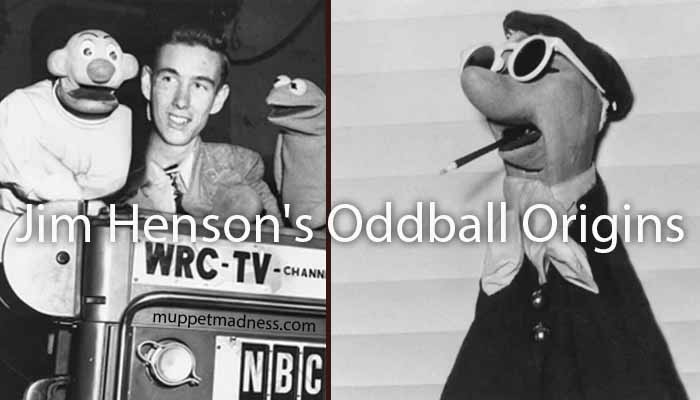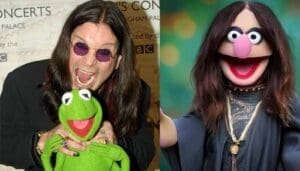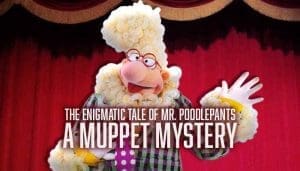The Muppet Master’s Misfit Muse
Everyone knows Kermit the Frog, Miss Piggy, and the gang. They’re household names, cultural icons, and the reason many of us still hum “Mah Na Mah Na” in the shower. These beloved characters brought joy to countless households and have become timeless additions to the entertainment business. But before the global phenomenon of The Muppet Show or even the beloved Sesame Street, there was Sam and Friends, a short-form television series that first aired on May 9, 1955. And before Sam and Friends? Well, that’s where the real, delightfully quirky story of Jim Henson’s earliest creations begins.
Imagine a young Jim Henson, not yet the visionary puppetry maestro, but a high school kid who just wanted a job in television. His path to becoming a legend wasn’t paved with felt and foam from day one; it was a winding road of surprising detours, accidental discoveries, and perhaps, a few questionable puppet choices. His journey was marked by a restless curiosity and an innovative approach that would build the Muppets into an enduring international brand. Get ready to dive into the hilariously humble origins of the man who redefined puppetry, long before a certain green amphibian stole our hearts.
From Mississippi to Maryland: A Young Jim’s Unlikely Path to Puppetry
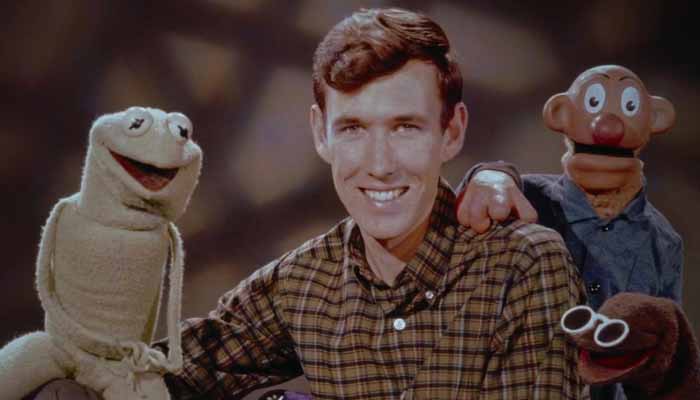
James Maury Henson was born in Greenville, Mississippi, in September 1936. His family later moved to Hyattsville, Maryland, when he was around 11 years old, a move that would prove pivotal for his burgeoning interests. From a young age, Jim was drawn to the arts, a passion nurtured by his maternal grandmother, a painter, quilter, and needleworker who encouraged his creative explorations, including puppetry. He even performed puppet shows for his fellow Cub Scouts, showcasing an early inclination for performance.
The nascent medium of television captivated young Jim. He described the arrival of his family’s first TV as “the biggest event of his adolescence,” a sentiment that speaks volumes about its impact on his developing imagination. He was heavily influenced by the radio ventriloquist Edgar Bergen, who could talk without moving his lips, and by the innovative television puppeteers Burr Tillstrom of Kukla, Fran and Ollie and Bil and Cora Baird from Life with Snarky Parker. These early exposures undoubtedly shaped his understanding of how puppets could “appear to be real creatures” and interact with an audience.
Despite these early dabblings and influences, Henson’s initial foray into professional puppetry wasn’t driven by a burning artistic passion. It was, in fact, far more pragmatic. He simply wanted to work in television, a medium he adored and saw as “absolutely wonderful”. At just 16 years old, he began seeking jobs at local TV stations, but faced repeated rejections. Then, a stroke of luck: he heard a station was looking for a puppeteer. This pivotal moment highlights a foundational aspect of Henson’s approach: his adaptability and determination to seize opportunities, even if they led him down an unexpected path. His restless curiosity was a powerful driving force, pushing him to master whatever medium presented itself.
With no prior experience in professional puppetry, Jim did what any resourceful, aspiring TV professional would do: he headed straight to the library. He devoured books on puppetry, diligently built some homemade puppets, and applied for the job. And, against all odds, he got it! As Henson himself famously put it, with characteristic understatement, “It was interesting and kind of fun to do, but I wasn’t really interested in puppetry then”. This almost accidental entry into the world that would define his life is a testament to his sheer determination to break into television, showcasing a humble beginning that stands in humorous contrast to the global artistic empire he would later build.
The Junior Morning Show: Where the Magic (Sort of) Began
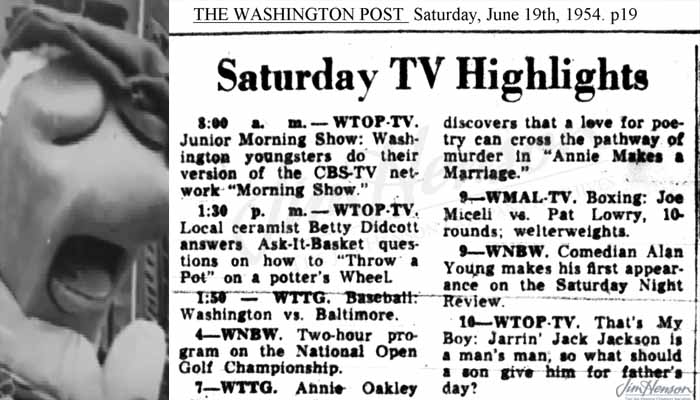
In the late spring of 1954, at just 17 years old and still attending Northwestern High School, Jim Henson landed his very first television job. It was on a Saturday morning children’s program called “The Junior Morning Show,” which aired on WTOP-TV, a local CBS affiliate in Washington, D.C.. The show’s concept was, shall we say, unique: it featured kids reading the news, often alongside puppets. Henson’s role was primarily to build and manipulate these puppets, as he wasn’t particularly interested in reading the news himself. This early exposure to live television in a somewhat chaotic, low-budget environment proved to be a critical “trial by fire.” It forced him to be resourceful with materials and to think on his feet, laying the groundwork for the improvisational spirit that would later define Muppet performances. The constraints of early television inadvertently fostered the very creative problem-solving and adaptability that would make Henson a visionary, turning limitations into opportunities for innovation.
While many sources confirm that the prototype Kermit the Frog was developed for Sam and Friends (which started in 1955), one specific character stands out as a true pre-Sam and Friends creation: Pierre the French Rat. Pierre was originally designed by Henson in a comic strip for his high school in 1954. Later that same year, he brought Pierre to life as a hand puppet with a plastic wood head specifically for “The Junior Morning Show”. Pierre was later repurposed and used on Sam and Friends, making him a rare, documented example of Henson’s earliest tangible puppet creations. An original Pierre puppet, made of latex, is even housed in the Smithsonian National Museum of American History, a testament to his historical significance. This early reuse of a character highlights Henson’s pragmatic tendency toward iterative character development, a process that would become a hallmark of his creative workshop. It also helps to clarify that Kermit, while an early Muppet, was not Henson’s very first puppet creation.
Unfortunately for Henson, “The Junior Morning Show” was short-lived, lasting only a few weeks in June 1954 before being cancelled. He continued performing puppets on another WTOP-TV show, Roy Meachum’s Saturday show, but that too was cancelled by August. These initial setbacks, however, proved to be mere stepping stones on his remarkable journey.
Here’s a quick look at Jim Henson’s documented TV engagements and known puppet creations before Sam and Friends:
| Year | TV Show/Segment | Network/Station | Key Details/Format | Notable Puppets/Characters |
|---|---|---|---|---|
| 1954 | The Junior Morning Show | WTOP-TV (CBS affiliate) | Children’s show with kids reading news alongside puppets; Henson built and manipulated puppets. | Pierre the French Rat |
| 1954 | Roy Meachum’s Saturday Show | WTOP-TV (CBS affiliate) | Henson continued performing puppets after “Junior Morning Show” cancellation. | Unspecified homemade puppets |
| Feb 1955 | Afternoon show | WRC-TV (NBC affiliate) | Henson began performing with puppets, collaborating with Jane Nebel. | Unspecified puppets, carried over from previous work |
Beyond the Morning Show: Lip-Syncing, Foam, and the Dawn of a New Era
Despite the short-lived nature of his initial gigs, Henson’s talent was noticed. He was referred to WRC-TV, the local NBC affiliate, where he continued performing with his puppets. In February 1955, while still in college, he began performing as part of WRC’s “Afternoon show”. It was here that he began working closely with Jane Nebel, a fellow University of Maryland student he met in a puppetry class. Jane would become his first performing partner, future wife, and a crucial collaborator in shaping the Muppets. Their partnership was instrumental in developing the distinct style that would define his later work.
In these early shows, including “The Junior Morning Show,” “Afternoon,” and even the initial phases of Sam and Friends, Henson’s puppets primarily lip-synced to popular songs or comedy records. This technique, influenced by other TV puppeteers like Bill Baird , allowed for immediate comedic effect and visual gags without the need for complex voice acting from Henson himself. It was a period where physical comedy and visual timing were paramount. This heavy reliance on lip-syncing highlights a period where visual humor and physical comedy were paramount. This constraint, rather than limiting creativity, likely forced Henson to hone his skills in character movement, timing, and non-verbal expression. The humor would have come from the absurd juxtapositions between the puppet’s actions and the pre-recorded audio, or from the sheer physical antics, laying the foundation for the Muppets’ later slapstick and burlesque style. Henson only started to talk for his characters more regularly with the Wilkins Coffee commercials, which began in 1957, after Sam and Friends had already started.
It was during this period, leading into Sam and Friends, that Henson truly began to revolutionize puppetry for television. Traditional puppet shows were often filmed as if on a miniature stage, with a proscenium arch framing the action. Henson, however, saw the television camera as his stage. He pioneered the technique of keeping the puppeteers hidden outside the camera frame, allowing the puppets to appear as if they were truly alive and interacting directly with the viewer. He and Jane would watch themselves on a monitor, tailoring their performances for the screen, a groundbreaking approach at the time. This deliberate departure from traditional stage puppetry to leveraging the camera frame as the “stage” signifies a fundamental shift, recognizing television’s unique capabilities. His early TV experiences, even the short-lived ones, were crucial laboratories where he experimented and refined these groundbreaking techniques, moving puppetry from a stage adaptation to a native television art form.
Henson believed that television puppets needed “life and sensitivity”. Moving away from the stiff, carved wooden puppets common at the time , he began building characters from softer, flexible materials like foam rubber and fabric. This allowed for a wider range of emotions and more accurate mouth movements to match dialogue or lip-syncing. His use of thin rods for arm manipulation, unlike cumbersome marionette strings, also provided greater control and expression. These innovations, though fully realized with the Muppets in Sam and Friends, were clearly incubating in the pre-Sam and Friends period, demonstrating his early commitment to pushing the boundaries of the art form.
The Pre-Sam & Friends Puppet Parade: Who Else Was There?
While Pierre the French Rat is the most clearly documented puppet created for “The Junior Morning Show” , the available information indicates Henson was building “homemade puppets” for his initial TV work and “built several new ones” for the “Afternoon” show. Details on these specific, unnamed puppets are scarce, suggesting his early roster was experimental and constantly evolving. No other named characters are definitively confirmed as being created before Sam and Friends and not for it.
It’s important to note that the term “Muppet” itself was coined by Henson to describe his characters, a portmanteau of “marionette” and “puppet”. While many early Muppets were hand puppets or rod puppets , the core “Muppet” aesthetic of flexible faces, wide mouths, and large protruding eyes was still taking shape. These early creations were the raw, unpolished prototypes that would eventually lead to the iconic characters we know, a testament to a continuous process of refinement.
Even in these nascent stages, Henson’s signature “gently subversive humor” was evident. Anecdotes suggest that early sketches often ended with one character “eating the other or blowing the other one up”. This dark, playful absurdity was a consistent thread, hinting at the anarchic fun that would later define The Muppet Show. This early comedic sensibility, present from his very first televised efforts, suggests that the core of the Muppets’ unique brand of humor—unexpected, slightly dark, and often pushing boundaries—was ingrained in Henson’s creative DNA from the very beginning, a fundamental aspect of his identity rather than something developed later.
The Grand Finale (Before the Real Grand Finale): Setting the Stage for Sam and Friends
Henson’s work on the “Afternoon” show with Jane Nebel proved successful, a clear indication that his innovative approach was gaining traction. This success led to WRC-TV offering Jim his own daily five-minute show, which would become Sam and Friends. The first episode aired on May 9, 1955, marking a significant milestone in his career.
It was for Sam and Friends that Jim Henson created the earliest prototype of his most famous character, Kermit the Frog. This original Kermit was a “light bluish-green abstract creature” made from Jim’s mother’s old spring coat, a pair of his blue jeans, and ping-pong balls for eyes. He started as a lizard-like character and evolved into the iconic frog we know today. The term “Muppet” itself was coined by Henson around this time to describe these new characters, a portmanteau of “marionette” and “puppet”.
While Sam and Friends was a financial success and even won a local Emmy Award in 1958 , Henson initially had doubts about pursuing puppetry as a long-term career after graduating college. It would take a transformative trip to Europe in 1958 – after Sam and Friends had begun – for him to truly see puppetry as a valid art form and a serious career path. This highlights that even as Sam and Friends launched, Henson’s journey of self-discovery and artistic commitment was still very much in progress, underscoring that even the greatest creative journeys often involve moments of uncertainty and evolving purpose.
Conclusion: A Hilarious History Lesson (and a Call to Action!)
From a high schooler just trying to get a foot in the TV door, to a library-researched puppeteer on a bizarre morning show, Jim Henson’s path before Sam and Friends was anything but conventional. It was a period of rapid learning, technical innovation, and the quiet incubation of a comedic genius. His pragmatic drive to simply “get a job” in television inadvertently led him to master puppetry, transforming a practical necessity into a revolutionary art form. The “trial by fire” of early local TV, with its quick turnarounds and limited resources, forced him to innovate, developing techniques like using the camera frame as his stage and crafting soft, expressive puppets.
While Kermit wasn’t quite ready for his close-up yet, the stage was being set by unsung heroes like Pierre the French Rat, the only specifically named puppet confirmed to exist before Sam and Friends. These early, often overlooked, years were crucial. They were the proving ground for Henson’s revolutionary approach to television puppetry, where he honed his craft, experimented with materials, and developed the gently subversive humor that would become his trademark. The reliance on lip-syncing in his earliest work also pushed him to excel in physical comedy, laying the groundwork for the slapstick and visual gags that would define the Muppets. Without the humble beginnings on “The Junior Morning Show” and “Afternoon,” the world might never have met the Muppets as we know and love them. It’s a funny, fascinating reminder that even the greatest creative journeys often start with a simple desire to “just get a job,” blossoming into something far beyond initial expectations.
What’s your favorite obscure Jim Henson fact? Did you know about Pierre the French Rat? Share your thoughts in the comments below! Discover more about the Muppets’ origins and Jim Henson’s early career on our blog!

